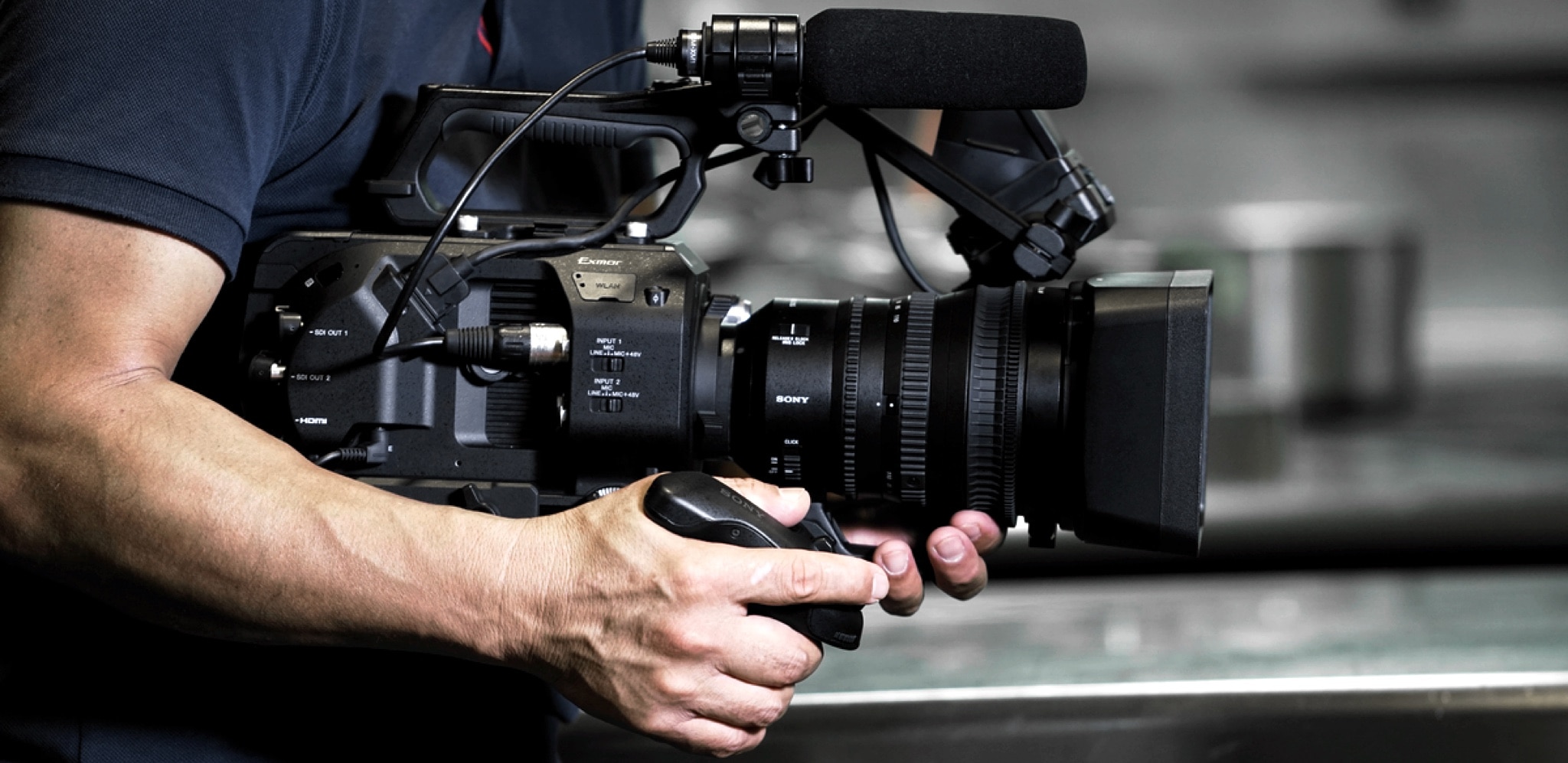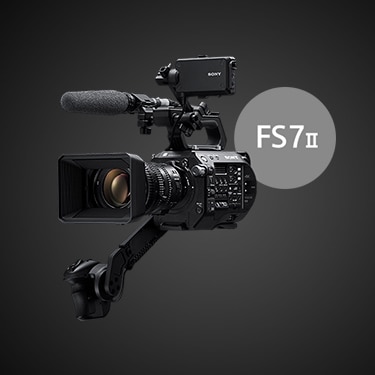FS7 II team interview
The phenomenal success of the original FS7 owes much to in-depth research by Sony into the real world requirements of documentary makers. Highly confidential discussions with trusted customers were constantly referred to in developing the FS7’s radical new design.

In-depth interview with FS7 II development team
For FS7 II, by contrast, conventional customer research became almost irrelevant due to intensive FS7 social media discussions, critiquing every feature however small and demanding improvements from what might come next. This was hugely beneficial to the team… but also made clear FS7 was being used for countless applications never considered by the original team laser-focused as they had been on documentary makers. For FS7 II it seemed every possible application was in scope; everything from commercials to news programs, variety shows to feature films.
Meeting these sky-high expectations demanded a thorough re-engineering of countless aspects of FS7 – remaking almost everything without spoiling anything that made the original such a hit.
“The FS7 II was designed to incorporate all of the feedback we got on the FS7 and aim even higher,” says Mr Oishi, the person in charge of product planning.

It may look the same, but FS7 II is a completely different product.

The first professional camera designed by social media?
“We actually checked blogs and social networking sites daily and put that to use during development,” says FS7 II project leader Suzuki. In his 19-years at Sony, Mr Suzuki has always highly valued customer research, even if experience has taught him how easily critical nuances and subtleties can be lost. Social media removed that filter.
Mechanical engineer Mr Ito agrees, “I remember how many people had uploaded pictures of shooting with the FS7 on Instagram. You could see at a glance that this was how they were customising it, or this was how they were using it. It was extremely educational and we were able to use it in the design.”
For example, once the team learnt about the FS7 being used for ENG applications, they adapted the Electronic Variable ND Filter to include features such as a one-touch auto ND function and support for using the feature when shooting in full auto.
“Frank talk is extremely useful in creating something good,” Suzuki explains. “In the future, even if it’s just something small, feel free to share; we will be sure to pay attention and take it seriously.”
Run and gun ergonomics redefined
“At first glance, the body may look the same, but the FS7 II is a completely different product,” says mechanical engineer Mr Ito.
Since FS7 was being used for so many different applications, customisation was a key focus for his team – they wanted to enable people to adapt the camcorder to how they worked, while they worked.
“For FS7 II, we worked to make it possible to implement a variety of customisations and to put things together and take them apart again without tools. We also made it possible to make a variety of adjustments quickly and easily with one hand.”
For example, when adjusting the length of the grip arm on the FS7, loosening the screw would cause the grip to simply drop to its longest length. Aiming to make it possible to adjust the arm with just one hand on the FS7 II, Ito’s team added a braking mechanism in the arm to stop it at any arbitrary position; they also made it possible to tighten the screw without using any tools.

The braking mechanism is just one of the FS7 II’s many improvements not visible from the outside, but Mr Ito says they went through a great deal of trial and error to find the right tension and braking force. The team even reviewed how the camera and arm interacted to minimise any chance of fingers being caught.
Another example of this attention to detail are the FS7 II’s screws where the threads are rolled after attaching the washers, preventing the washers from falling off when changing arm positions during filming.
FS7 customers emphasised how setting a camcorder down to make adjustments, even for just a few moments, can be costly in precious shooting time. Ito and his team aimed to enable adjustments that could be made easily even while the camera was shouldered.
In addition to the changes to the arm’s operation, the team modified the eyepiece mount so it could be attached and removed with one hand. More clamps were added to make it easier to attach and remove the mic holder, increasing convenience when packing up, and a folding hood was added for when using the viewfinder like a monitor.
“Speaking as an engineer myself, nothing makes me happier than knowing all this work is of even the smallest aid to people in creating the films they have dreamt up,” Suzuki says.
User feedback also focused on the positioning of the viewfinder. The FS7 uses 15mm diameter round rods as they are the industry standard, however user feedback revealed this made it difficult to keep the viewfinder level when adjusting its position. The team went back to the drawing board and revised the design to use square rods, eliminating the problem, while also including an adapter so the user can still use a traditional round rod if desired.
Ito says that they aimed for a design that go beyond answering the feedback they received, but would also be forward-looking and anticipate the needs that would emerge from their changes.
‘God is the details,’ is Mr Ito’s motto and it’s no surprise that the detailed improvements applied to the FS7 II do not stop here. Further examples include the addition of easily visible, assignable buttons, changing how the audio control button cover opens from horizontal to vertical, improving waste heat efficiency by revising the internal design and heat dissipation paths, changing how far out XQD cards eject (to be more easily extracted), and even improving the sound of the XQD card slot cover when it is opened and closed.
In fact, over half of the moulds for the FS7 II’s body are different from the FS7. So while it may look the same as the FS7, this is the birth of a whole new camcorder.

Electronic Variable ND Filter: Game-changer
Sony’s innovative Electronic Variable ND Filter technology made its first appearance a year after FS7’s launch with the X160 camcorder, then became a key feature for the FS7’s little brother – the compact FS5. It was clearly a must-have for the FS7 II, but needed to fit in a space just 18mm deep that would also incorporate the all-new Lever Lock type E-mount. As we’ll see later, this would require exceptional engineering, but first let’s cover why it’s so critical. In general, we use the iris to change exposure, but this also changes the depth of field. Using the Electronic Variable ND Filter, you can either maintain depth of field while changing exposure or maintain exposure and change depth of field.
This has an obvious benefit in making it easier to shoot with FS7 II and achieve a consistent look, particularly in the highly mobile scenarios it was designed for. However, it also has an impact on image quality as you can now more easily use the sweet-spot aperture range of the lens, which is typically around F5.6-F8, and avoid closing the aperture to the point where diffraction in the lens optics will cause image blur. When shooting at high resolutions such as 4K (and beyond) this feature is a real game-changer.
Once you try it, you will never want to shoot without it.
Mr Oishi
E-mount re-made
A key part of FS7’s appeal is Sony’s E-mount which helped keep the camera compact and lightweight, while providing the widest possible range of compatible lenses…
However, as FS7 users were using the camera for ever more ambitious projects, there was a clear demand to strengthen the lens mount to support heavier lenses. This would prove to be one of the FS7 II’s most challenging engineering tasks.
Adding both strength and rigidity would be difficult enough, but mount design head Miyao had to do this without changing the camcorder’s dimensions.
“In practical terms it’s a whole new mount; there were thus a lot of things we had to consider and things we could only understand after trying them,” says mount design head Mr Miyao. “With the E-mount, there’s just 18mm between the mount surface and the image sensor. It was constant anguish packing everything into that space.”

Miyao’s previous work includes the stunning RX100 pocket camera, but FS7 II posed a unique challenge. The FS7 II uses a mount in which the outer mount ring is rotated and the lens is kept fixed similar to PL and B4 mounts, but the E-mount on which the new mount was based had a flange back that was just 18mm.
Numerous mechanisms had to fit in the space in addition to the mount mechanism itself, including the Electronic Variable ND filter, an IR cut filter, and a low pass filter. The entire Electronic Variable ND filter unit in particular is designed to slide out of the way using motors when ND is off. In addition, because the refractive index of the ND filter and air differs, just moving the unit out of the way changes the back focus. Accordingly, not only must the ND filter be moved out of the way, a different clear filter with the same refractive index has to be moved in.
In addition, the mount had to be sturdy enough to carry the weight of the various lenses and accessories users would be attaching while still maintaining the FS7’s optical performance. The challenge faced by Miyao and his team was to come up with a design that would incorporate these complex mechanisms while at the same time being sufficiently sturdy, in a space of just 18mm.
Compared to a mount with large dimensions and plenty of room like the PL mount, the precision necessitated by the Lever Lock type E-mount’s design and manufacturing is an order of magnitude higher, and Miyao says achieving that precision with mass production was a trial.

The E-mount’s flange back is not just small, the thickness of the clasp, the key to maintaining rigidity and the hardware on which the lens mounts, is also limited, resulting in the angle of rotation when moving the mount being much smaller in comparison with the PL mount. With such a small angle of rotation, there were fears that the repeated sliding of surfaces against each other when rotating the mount would result in wear that might make it impossible to keep a lens firmly fixed after many uses.
A special processing treatment called ‘nitriding’ was used on the FS7 II’s mount clasp to increase hardness, dramatically improving wear resistance. This technology has never before been used with a conventional lens mount. The team went so far as selecting a brand new grease for the mount rotator cuff and designing the perfect feel when users rotate the mount.
The team also had to consider customers’ subconscious expectations of how the mount would operate: the E-mount had originally been developed for mirrorless SLR cameras and thus the direction the new mount is the opposite to other common video camera mounts. To prevent users familiar with the PL and B4 mounts rotating the mount the wrong way and dropping a lens, the new mount for the FS7 II is equipped with a double latch mechanism.
Miyao’s team was adamant about the double latch: “People may forget to use a manual lock. Then the lock serves no purpose at all.” Miyao’s team wracked their brains to find a way to design the mechanics of the lock. Then, after re-designing the lens mount, Miyao and his team discovered they would not be able to use a conventional mount cap. Because the camera mount itself rotated, the cap would rotate with it. Accordingly, they also had to develop a new cap!
An experience that’s more than a spec list
FS7 delivered a revolution in usability that FS7 II improves upon in almost every way.
Suzuki notes how important customer feedback was in driving these changes, but worries that the innumerable improvements made throughout the FS7 II are not apparent at a glance. The information posted in product brochures and on websites tends to only include the most high profile features; how it really feels to use is something that is very difficult to present with just words.
Suzuki brought our interview to a close with the following remarks: “I want as many people as possible to actually hold FS7 II in their hands and experience for themselves how it feels to shoot with it. There’s countless changes, big and small, developed with great care by many, many engineers at Sony.
“Speaking as an engineer myself, nothing makes me happier than knowing all this work is of even the smallest aid to people in creating the films they have dreamt up.”


